#questing beast
Text
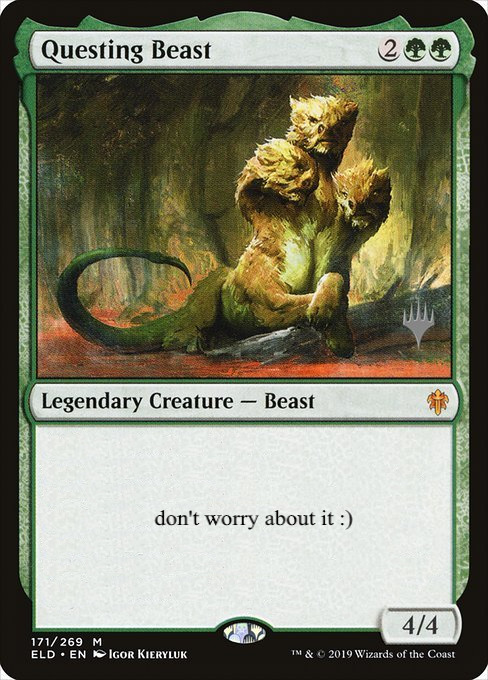
940 notes
·
View notes
Text

Questing Beast
Simple metal cared for so well it’s said to harbor every color in its cool grey tones. Even if the Questing Beast is new to the public (criminal) record there is already some dreaming of what knightly person is the pilot of such a beautiful machine.
Few are prepared for the man who’s spat on his knuckles before breaking a skin head’s jaw, taken several beer bottles to the face, and shat on the grave of one of the most highly adorned Captains of the United Core. For someone who was dismissed from the Core Military with high honors (and a Purple Heart). He seems to have doubled in sourness since. Warraun is dangerous in close combat and easy to provoke. You shouldn’t have a problem with him. Mech seem’s to be using the Black Beard frame for two licenses and one in Tortuga
- Manage P’s report to Kol
#IM SO PROUD OF THIS BAD BOY#finished on the 15th of January#questing beast#mech#Warraun#lancer#lancer rpg#mecha#lancer ttrpg#my art#art#digital#color#painting#digital art#concept#creature#illustration
197 notes
·
View notes
Text

"Pellinore hunts a strange unique creature, the Questing Beast, which his family is fated to pursue, though neither they nor anybody else will ever catch it." (Diesel / David S LaForce, "Arthurian Heroes" section of AD&D Deities & Demigods, TSR, 1980) The Beast Glatisant, the Questing Beast, is not given its own heading or stats in this volume, but the illustration matches some medieval accounts of a creature with stag's feet, a serpent's head, leopard's body, and lion's haunch and tail. So: hooved, long neck, spotted, yellow/orange/brown in color, with a darker bushier tail tip, all point to it being based on misunderstood descriptions of a giraffe.
#D&D#Dungeons & Dragons#David S LaForce#Deities & Demigods#King Pellinore#medieval#Questing Beast#Beast Glatisant#Diesel#Arthuriana#Arthurian legend#Arthurian heroes#giraffe#AD&D#dnd#bestiary#1980s#Dungeons and Dragons#TSR
264 notes
·
View notes
Text

Bestiary🦁🐴🐔
Finally drawing the thing I want to draw for a long time which is renaissance black armor angel and the questing beast! and they're all friend:)
(sketch and inspiration below)

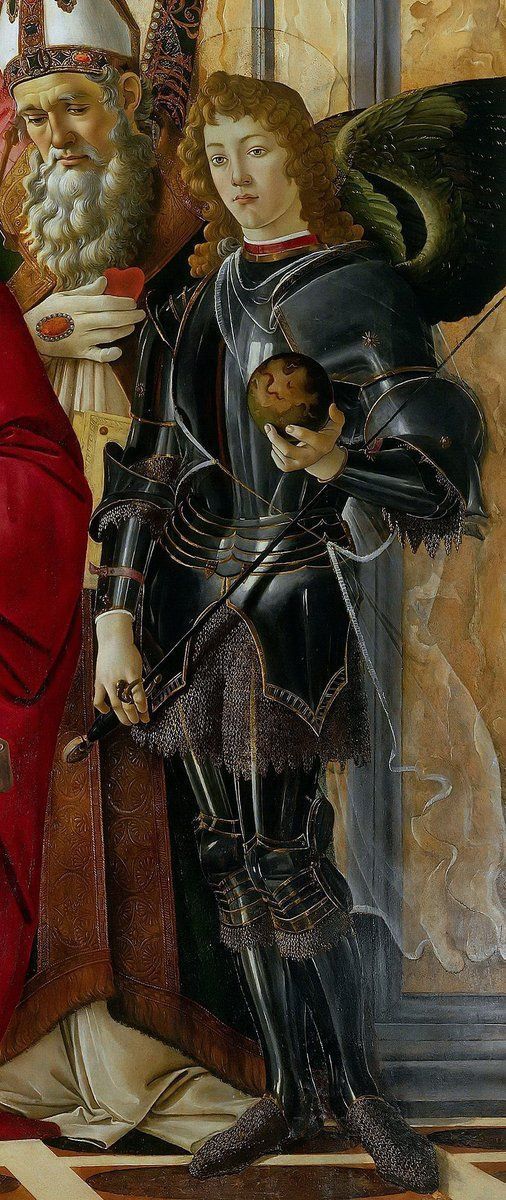

#medieval fantasy#angels#my art#illustration#artists on tumblr#basilisk#unicorn#chimera#questing beast#spend time reading medieval bestiary then vroom#feels good to draw no context original art#they're in the same categories for me
134 notes
·
View notes
Photo

Source details and larger version.
Monsters of every stripe are collected here.
222 notes
·
View notes
Text
Eureka: Investigative Urban Fantasy and Warhammer 40,000
youtube
Super interesting video by Questing Beast about some of the earliest ancestors to what would come to be known as a "tabletop roleplaying game," and the wargaming roots of TTRPGs as a whole.
I, the lead rules writer for Eureka: Investigative Urban Fantasy have been a Warhammer 40,000 player for years, and I love to brag about the way that Eureka as a TTRPG is in touch with its wargaming ancestry, both in ways you would and wouldn’t expect.
Playing Warhammer 40,000 has helped me get a good sense for dice probability, especially with regards to the D6s that Eureka uses, and is one of the things that gave me the idea for how Eureka handles firearms, particularly those with high rates of fire.
In Eureka, one single hit from a bullet is enough to incapacitate a human character, and automatic weapons can fire up to 10 or even 12 bullets in a single action. Each one of these bullets has the potential to be devastating if it hits.
Lots of factors affect the probably of a shot hitting a target, and most of them affect it by making the probability go down. Shooting 1-3 shots in a single turn will be rolled by the standard and highly predictable 2D6 that Eureka normally uses, but beyond that number, D12s are used for each shot, which not only makes the rolling of 4+ shots easier because you can scoop a bunch of D12s up in one hand and throw them all at once without having to keep distinct pairs together, but also makes each individual dice roll swingier, and slightly more likely to be a lower number.
Therefore, just like in real life, automatic weapons increase accuracy by increasing the volume of shots fired, increasing the chance that at least one of them will hit. Because any given 9mm fired is just as deadly as another, whether it’s fired by itself or as part of a large burst.
It was Warhammer 40,000’s mechanics that filter massive numbers of attacks through Accuracy, Wounding, and Armor Saves, when only a few of these attacks need to get through in order to be effective, that helped put me onto this idea.
There is also the fact that, despite primarily being a neo-noir Investigation game, Eureka’s rules also allow for players easily controlling multiple characters at a time and the potential for more militaristic scenarios, with each individual PC being super fragile with simple HP that is super easy to keep track of even across multiple character sheets.
Then, there are quite a few things about Eureka that one might not expect to have come from a wargame.
For one, we get a lot of praise for how each section of the Eureka rulebook is ended with a series of bulletpoints that summarize all the key rules and ideas in the paragraphs above. Well, I got the idea to do that from Warhammer 40,000 rulebooks.
There is also a mechanic in the past few editions of Warhammer 40,000 called “Command Points.” Command Points are a limited resource that can be spent to gain small advantages in the game, such as rerolling a single die, or activating the special abilities of certain units. There is a set of universal Command Point abilities that all factions share, as well as every faction having their own set of Command Point abilities unique only to them.
It is no coincidence that Eureka sports a very similar mechanic. You can find more information about this by reading "Investigation and the Eureka! System" in the Eureka prerelease rulebook, which you can download for free right here, but the short version is that as investigators investigate, they gain Eureka! Points. It can take an awful lot of investigating to gain a single Eureka! Point, which makes them a very scarce resource, but they can be spent on valuable bonuses, such as retroactively un-failing a previously failed Investigation check and getting the clue that would have been obtained from it (We call that a “Eureka! Moment!), or adding an extra D6 to an important roll, increasing the probability of success. Those are just the universal ones, however, that every PC has. Like Command Point abilities in Warhammer 40,000, there’s a set of universal ones, but most of them are exclusive.
Certain Traits unlock other Eureka! Point abilities exclusive to PCs who have those Traits, one of my favorite of which being the Eureka! Point ability that the Final Girl Trait unlocks, which allows spending a Eureka! Point to decrease the probably of success for an aggressive monster’s roll, helping simulate the trope of the “final girl” being able to just barely slip out from the jaws of death due to a sudden stroke of luck.

Another one of my favorites is a set of Eureka! Point abilities unlocked by the monster-exclusive Unkillable Trait. These abilities allow monsters, PC or NPC, to suddenly and unexpectedly return to the narrative after seemingly having been killed by losing all their HP. The more Eureka! Points spent, the sooner more immediately the monster can return.

If any of this sounds interesting to you, you can back our Kickstarter before it ends on May 10th and get a copy on release! We are also doing physical copies now!
Oh, and just one more thing..

Eureka Mention!
If you want to try before you buy, you can download a free demo of the prerelease version from our website or our itch.io page!
If you’re interested in a more updated and improved version of Eureka: Investigative Urban Fantasy than the free demo you got from our website, subscribe to our Patreon where we frequently roll our new updates for the prerelease version!
You can also support us on Ko-fi, or by checking out our merchandise!
Join our TTRPG Book Club At the time of writng this, Eureka: Investigative Urban Fantasy is the current game being played in the book club, and anyone who wants to participate in discussion, but can’t afford to make a contribution, will be given the most updated prerelease version for free! Plus it’s just a great place to discuss and play new TTRPGs you might not be able to otherwise!
We hope to see you there, and that you will help our dreams come true and launch our careers as indie TTRPG developers with a bang by getting us to our base goal and blowing those stretch goals out of the water, and fight back against WotC's monopoly on the entire hobby. Wish us luck.
#eureka: investigative urban fantasy#ttrpg#rpg#roleplaying#eureka#tabletop#coc#monsters#youtube#questing beast#dnd#dnd 5e#d&d 5e#5e#wargaming#40k#warhammer 40k#wh 40k#wh40k#imperial guard#warhammer#warhammer 40000#warhammer fantasy#warhammer40k#games workshop#space marines#ttrpgs#ttrpg community#ttrpg tumblr#ttrpg art
25 notes
·
View notes
Photo

Questing Beast
Artist: Igor Kieryluk
TCG Player Link
Scryfall Link
EDHREC Link
#mtg#magic the gathering#tcg#$4.84#igor kieryluk#questing beast#throne of eldraine promos#legendary#creature#beast
115 notes
·
View notes
Note
Hi! I hope I do not bother you, but I'd like to ask a thing (if you already answered this in another ask I'm sorry) because you seem to be the most qualified person to answer. In a retelling, when how much is too much changing? I am writing two whole Arthurian fics and while I mostly mix and match from different versions there are some things I fully changed (one of the most egregious, for example, being Palamedes dying early in Post-Vulgate fashion and Safir as the one who slays the Questing Beast and the killing being an expression of vengeance instead of newly-found peace despite this definetely not being the case in the original text). I think what I changed works better for plot reasons but I am a bit uncomfortable with it, especially when it comes to characterization. But on the other hand there are so many different versions that I find it hard to say if I am ruining it or not because even in the canon plots and characters' personalities change a lot but I don't want to do something that ends up being "in name only". When is too much too much?
Hello! I don't know about being the most qualified person to answer, but I can certainly give you my answer! I've explained this a little bit before here and here, but can elaborate again for you, especially because I think those characters and that text in particular should be handled with care.
Before you determine what amount of reinterpretation constitutes the right balance, pause everything, and pinpoint your audience. Are you writing fanfiction for your own self-fulfillment and enjoyment? Maybe also for a handful of friends who share your ideas? In that case, there are no rules, do whatever you want. That's your space, your story, and you bear no responsibility to uphold some unquantifiable standard of characterization "accuracy." Fandom is your sandbox and you can build whatever castle you want! Be free!
The next thing to determine is what characters you're changing and why. Not all changes are created equal! For example, if you wanted to absolve Arthur of the May Day Massacre to write a more honorable King, it's not all that drastic a change. There are many texts, old and new, in which that narrative beat never occurs. If noble Arthur serves your story better than morally gray or evil Arthur, and it can be done without compromising the Arthurian fabric from which you sample, go for it. Alternatively, if you decided to incorporate additional violence into the story, especially if attributed to a character who had not previously done those things (such as rapist Gawain, ie, inverting his Maiden's Knight role he's known for), you're going to have a harder time selling the reader on it. Generally speaking, a positive or neutral change will always be easier to sell than a negative one.
This is especially important if you intend to publish something you write for a broader audience. That's a different matter, in my opinion. In that regard, the thing you create is contributing to an Arthurian body of work that's meant to stand on its own. Fanfiction exists in a writing niche which assumes a base knowledge from the reader, you may not necessarily explain what Camelot is, or what chivalry means, or who Palomides is. That's fine and dandy. It's for fun!
But with a published book standing alone on the shelf, the author is expected to establish the framework of the world their story takes place in. That may or may not align with "canon" and therefore maintain or depart from the expected. This is where your decisions as an author matter. While Arthuriana is anachronistic by design as a literary tradition that's evolved alongside its authors, the moment you decide on an era to write in (if you put a year to it or imply one based on what historical aspects emerge), you now bear responsibility to depict that as accurately as you can. Even if it's a mishmash of "Medieval" spanning a few centuries, it should still bare resemblance to the era. Particularly in our current political climate with constant misinformation and even disinformation spreading, it's important to do the research necessary to create something genuine so as to avoid misrepresenting the past and the people in it. For example I think it would do a disservice to an Arthurian story to ignore religion, particularly one about Palomides or his brother Safir. To write them as areligious is to ignore the role in the Arthurian narrative they were created for. They're Saracen, (even if Palomides converts in some versions), and to ignore the way religion and race interconnect in Medieval society would be disingenuous.

[Idols in the East: The Saracen Body by Suzanne Conklin Akbari]
And, more to your point, that aspect informs character. The stories define Palomides by his religion, by his race, and how that impacts him in the face of a rivalry with Tristan, a white Christian, for the love of Isolde, another white Christian. This isn't to say that you're obligated to depict racism, or to put the characters into situations that oppress and hurt them, but to write something "race blind" is to erase the character's identity, and that would be too great a change, for me personally, to get by.
That being said, if you're writing in 6th century Britain, your research might lead you to think, "Hey wait a minute, Islam doesn't exist yet! But Palomides and Safir are written as Muslims, so how can I stay true to both the era I'm writing in and the characters if that anachronism is built right in?" Well, that's where you have wiggle room to be creative! Perhaps they're Zoroastrians or follow one of the many Berber religions that existed at the time. Even Tristan could reasonably be written Pagan in this era, as he has in many retellings before you sent this ask. Maybe Tristan's Mithraic or Druid or Jewish and that in and of itself helps mitigate some of the tension between the characters as neither are Christian. All of this should be handled with great care, of course, but the point is that there aren't really straight answers about what changes are worth making.
Your discomfort in this isn't unjustified. I've been there. But it doesn't mean you're doing anything "wrong." It's not a crime to conceptualize changes. I had a lot of anxiety writing Ragnelle and her brother Gromer as Zoroastrians. But I went on to find an editor who studied the religion, and asked my Zoroastrian mutual for help, who put me in touch with a practitioner that agreed to beta read my books and inform me on my handling of it. There's no perfect story, but all you can do is give it your best effort.
I don't think it'll benefit you to worry about "ruining" the story with changes such as Safir pursuing the Questing Beast. That sounds awesome! And your plan about vengeance is baked right into the source material, as the Post Vulgate indicates that QB had killed all of Palomides's brothers before he finally defeated her, so your story has some textual basis in a medieval source. (Not that you need it to be "allowed" to write that, but it may help your anxiety to know!)

[Post Vulgate Quest for the Holy Grail: 87. Galahad and Bors Chase the Questing Beast and Meet Palamedes and His Father, Esclabor the Unknown.]
One other thing I'll point out is choosing the language you use matters a lot. You can have some characters behave a certain way toward Palomides or Safir or this "futile" quest that resembles historical prejudice while utilizing word-choice throughout that signals to the reader you, the author, know what you're doing and understand the nuances at play. Reading broadly will help you with this so much. Not just non-fiction for your research, but other Arthurian retellings as well. I personally didn't love Persia Woolley's handling of Palomides in her Guinevere Trilogy. He was referred to as "the Arab" throughout which seemed like a "lesser evil" placeholder for "the Saracen." It's usage acted as a generalized umbrella term to other Palomides and didn't indicate his area of origin beyond constantly reminding the reader that he wasn't white. (Whereas Gawain was "the Orcadian" and Lancelot "the Breton," which differentiated their white cultures from one another while homogenizing Palomides with every other Eastern person in the story as a monoculture.) Furthermore, many characters were afraid of him (I mean literally making the sign of the cross and hiding when he walked in the room), which isn't consistent with a Post-Roman Britain, in which the population would have been mixed. I prefer the handling of Numidian Sagramore in Bernard Cornwell's Warlord Chronicles. Sagramore, as a Black man, is a part of Arthur and co's community, even if the Saxons themselves are unnerved by him. He's respected by the narrative. It's usually better to be specific (Numidian Sagramore versus Arab Palomides) particularly if that character is a minority and the word is leaving the mouth of a white character. This article discusses this aspect at length and really eased my own concerns depicting these characters and doing them justice.

[Saracens and Black Knights by Maghan Keita]
Here's another example of generalized versus specific language.
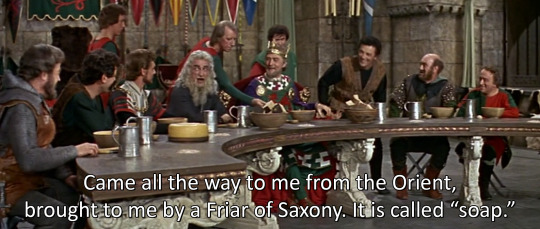
[Sword of Lancelot 1963: Merlin refers to "the Orient."]

[The Adventures of Sir Lancelot 1956: Merlin refers to "the Iberian Peninsula."]
So in my opinion, as long as you don't white wash Palomides or Safir and avoid writing them as "exotic" or "mysterious" or in some way barbaric in the pursuit of the Questing Beast, you're fine. Even in La Tavola Ritonda, Percival pursues QB for a time before Palomides picks up the quest, which is the opposite order in which that occurs in Post Vulgate where Percival and the other grail knights assist Palomides to defeat her at the very end. Many versions don't maintain the incest-monster aspect of QB from Post Vulgate either, like in Perlesvaus or Moriaen, she's just a monstrous creature and that's sufficient to tell the story the author has in mind. Even from a characterization standpoint, Malory wrote Palomides as volatile and melodramatic, having fits in the woods over his grief from which only Tristan could coax him out of, where in La Tavola Ritonda, Palomides is mostly chill and sweet, to the point Dinadan teases him for being a push-over haha! In regards to Safir, there's far less textual source material to base him off of than Palomides, so you have even more creative freedom! Literally the spectrum is so vast you can pretty much characterize however you desire if you keep in mind what the core of the character is and why that's important to their identity and the historical significance of that identity. (Even if it's something you have to bulk up, such as you will for Safir.) If you're ever unsure, it's never a bad idea to ask! Plenty of historians, or medievalists, Arthurian enthusiasts, or people of different cultures would love to discuss this subject. You might have to dig a little, but I can't imagine it'll be harder than my search for a queer Zoroastrian beta reader willing to read a trilogy-length Wedding retelling haha! It'll benefit your writing to submit to the mortifying ordeal of being known so others can give you feedback. Share some passages with a trusted few and gauge their reactions. Read what other people have done and take notes about the way they chose to characterize Palomides or Safir—did [aspect] resonate with you? Or did [aspect] ring false? Exploitative? Hollow? Why? Then step back, take another look, and go from there. It's about vibes and can't be defined, but you'll know when you know.
Hope this helps. Good luck and have a nice day!
#arthurian legend#arthurian legends#arthuriana#arthurian mythology#arthurian literature#palamedes#palomides#sir palamedes#sir palomides#sir safir#the questing beast#questing beast#glatisants#writing#orientalism#racism#history#islamphobia#xenophobia#anti blackness#colorism#ask#anonymous#my post
23 notes
·
View notes
Text

What if a questing beast again?
130 notes
·
View notes
Text
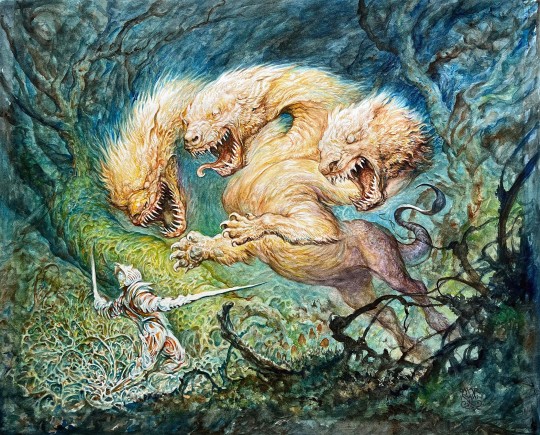
Questing Beast (Showcase Ver) by Omar Rayyan
#Magic the Gathering#MtG#MtGELD#Throne of Eldraine#Questing Beast#Showcase Version#Fantasy#Art#Omar Rayyan#Wizards of the Coast
38 notes
·
View notes
Photo

Lamb at Arms 4: The Knight, The Beast, and The Unicorn
<< Previous Page - Next Page >>
———
[Artwork for my illustrated “novel” mini thesis this semester! PDF preview will be available soon]
66 notes
·
View notes
Text
ROUND TWO, MATCHUP FOUR: QUESTING BEAST VS. MOTHMAN
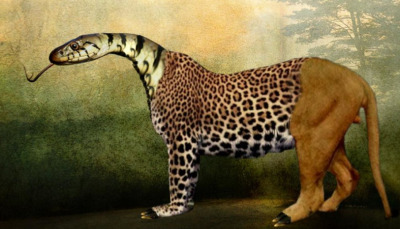
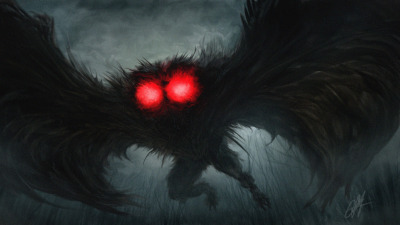
Let's be honest, we all know what's going to happen here. But in the interest of fairness... We have a medieval beast of yore, which turned out to be real! And we have a red-eyed Appalachian menace, with a very assy statue in their hometown!
78 notes
·
View notes
Text
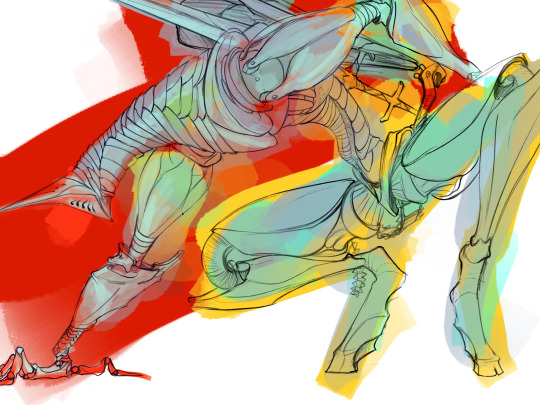
Sometimes I like the base layer of painting more than the final. Though I do plan on properly coloring the Questing Beast
#now I’m gunna draw Sisyphus as a birthday present to myself cuz- maybe a fourth dimensional being wants to marry his pilot but will not say#it’s a normal story I’m writing#I also- am overwhelmed by my own ideas of silver but also colorful in light reflections#cuz Nothing Can Be Simple#questing beast#mech#Lancer#lancer rpg#lancer ttrpg#mecha#Warraun#oc#my oc#my art#color#digital#painting#digital art#concept#wip
145 notes
·
View notes
Text

Do you see?
#Bardicious#A Story Undecided#original art#oc#original character#Bardicious Makes Art#my art#my illustrations#artists on tumblr#tumblr artist#Bardicious Sketchbook#sketchbook#digital sketchbook#Emrys Destroys Albion And Finds a Son#merlin#arthurian legend#king arthur#questing beast#lmao a legit question honestly xD
16 notes
·
View notes
Text
“Lucky me, the unicorn is a much stranger creature than my youth-brain initially understood. Beagle spends a ridiculous amount of prose space establishing that a unicorn isn’t a weird horse or anything like that, but its own specific amalgamation of various animal shapes that makes something distinct, precise, and important. There is so much care taken by the text in shaping the unicorn and letting the audience know that their generic expectation of a unicorn, horse-with-horn, is incomplete and lacking a complete image of what being a unicorn entails. When I was a kid, I was a guilty party who assumed that unicorn meant horse-with-horn. I was delighted to be wrong—it meant that I could be wrong about other things. I desperately needed to be wrong.”
— Hannah Abigail Clarke from their queer reading of The Last Unicorn
#the last unicorn#peter s beagle#ha clarke#h.a. clarke#Hannah Abigail Clarke#queer reads#queer analysis#gender dysphoria#questing beast
42 notes
·
View notes
Text
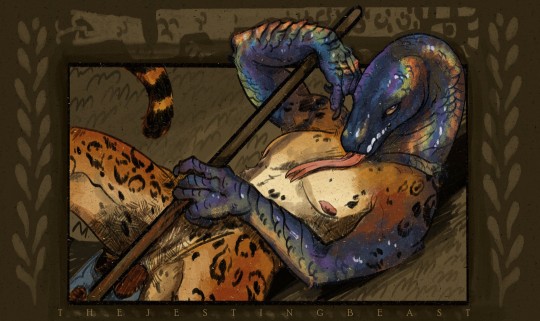
🌿🐆🌾🐍☀️
They blend together after a period of time- all these creatures. You weren't sure if this beast was the kind to ask riddles, or challenge a duel, talk in rhymes or-
__________________
Full can be found over on my alt Twitter (TheJestingBeast), but I figured this one's tame enough to share here too!
#questing beast#fantasy#drawing#suggestive#illustration#art#artists on tumblr#furry#artwork#digital art#painting#leopard#snake#white lipped python
55 notes
·
View notes